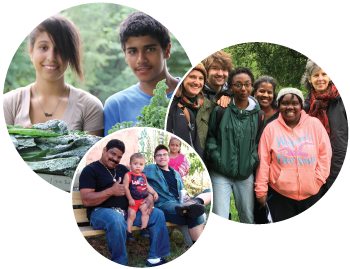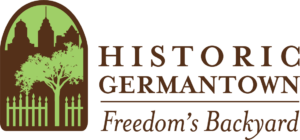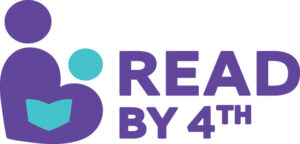Tour 1 Outside perimeter of the burial ground and Murals
Park on Cambria, south side of burial ground
See The old Fairhill Friends Meeting house corner Cambria and Indiana. 1883.
Now St. Johns Memorial Baptist Church, venue for Historic Fairhill programs
walk west to Germantown Ave, and turn right 100′
See the mural “Female Anti Slavery Society”
Pictures: Lucretia Mott, protesting black and white women, Martin Luther KIng, Jr,
Barbara Moffett of the American Friends Service Committee
This was the first female led, racially integrated political movement in the USA
“Am I not a woman? Are we not brothers and sisters?”
walk right on Germantown to the next building,
The Universalist Hagar Spiritual Church
See the mural, “Underground Railroad Mural”
see Lucretia Mott, Robert Purvis both buried at Fairhill with their spouses
see names of agents and conductors of the UGRR working in Philadelphia
read the text about UGRR and Fairhill Burial Ground
walk right up Indiana Ave. to corner 9th and Indiana
See mural “Together We Stand”
The Vietnam vet looks at his watch as if to say, “What time is it? I thought the war was over.”
Chollo and Yamira, teen boyfriend and girlfriend were killed on this corner during the drug wars
25 dealers stood on the corner, people died in drug houses, gunfire made streets too dangerous to go out
See mural, “Tribute to Peaches”
Peaches Ramos, block captain organized the neighbors
to help the police turn back the drug dealers who stood at the corner in the biggest open
air crack cocaine market in the city 1999-2001
Peaches was never harmed by the dealers who all knew her. Later, she visited Graterford
prison and the inmates where were painting the Healing Wall murals.
Walk north along 9th St. to Clearfield
See mural Officer Ortiz: from the neighborhood and killed in the neighborhood in the drug wars
Walk west to Germantown Ave
See murals “The Healing Walls: the Perpetrators Wall and the Victim’s Wall”
These murals were painted by inmates in Graterford Prison who had sold drugs in Fairhill
Peaches Ramos visited and they all remembered her as the one they respected and avoided
Tour 2 inside the Fairhill Burial Ground 1703
Enter through Cambria gate up the cobblestone path.
See the signs with Lucretia Mott, white Quaker minister, and Robert Purvis, black businessman
These great leaders of abolition and early women’s rights movements are buried here with their families.
Text: George Fox, the founder of Quakerism visited the US once and left this land to Philadelphia Quakers for
a Meetinghouse, a burying ground, a playground for children of the town to play and to grow simples ( medicinal herbs)
See map of the burial ground laid out in 1854, with grave locations
Lucretia and James Mott, white Quaker abolitionists and early women’s rights leaders E
Robert and Harriet Purvis, black abolitionists and early women’s rights leaders E
Mary Ann and Thomas M’Clintock – organizers of the Seneca Falls Conference on the rights of Women E
Anna Jeanes – Quaker donor who gave Booker T Washington $1million to start schools for black students in deep south
The Jeanes Supervisors set up a network of schools that became the first public schools for black children.
Edward Parrish – founding president of Swarthmore College, sent by President Grant to make peace in Indian territories.
See arboretum of great shade trees, including William Penn American Elm, Swamp White Oak, Sycamores, Linden,
See vault on lower path where bodies were stored in winter when ground was frozen
See history garden by the Indiana fence, with crops grown by succeeding cultures:
Lenni Lenape, English Quakers, German Mennonites, African Americans, Caribbean Hispanics
See picnic table with benches from 1900 Philadelphia Yearly Meeting –
This is where the Youth Garden Interns meet in summer to work in gardens and farm stand.
Rest yourself, Friend, on the benches.
Imagine this Fair Hill in 1703 with the little stream Gunner’s Run running down Indiana Ave. to Germantown This was forest and farmland
half way between the towns of Philadelphia and Germantown a days ride on horseback. Here the Quakers built a little brick Meetinghouse that became a field hospital in the War of Independence 1776-9
Imagine the Purvises defying the vigilantes to shelter enslaved people on their way to Canada in 1840’s and 50’s
Imagine Lucretia and James traveling up and down the early Republic preaching against slavery and organizing resistance. 1830’s-50’s.
Imagine Lucretia and Mary Anne planning the Seneca Falls Conference on the Rights of Women with Elizabeth Cady Stanton and two others. Imagine that first convention with their Declaration of Sentiments “We hold these truths to be self evident, that all men and women are created equal and endowed by the creator with certain inalienable rights. “1848
Imagine what we can do together today in Philadelphia to work for justice and bring more peace.





